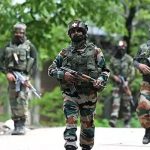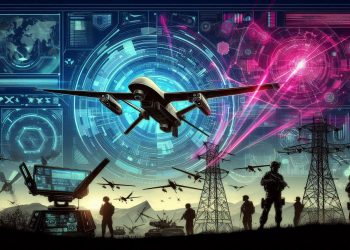Gone are the days when wars were confined to thundering tanks and roaring fighter jets. The modern battlefield extends beyond land, sea, and air—into cyberspace and even low Earth orbit. Armed conflicts are now shaped by artificial intelligence, autonomous systems, cyber warfare, and precision-guided digital weapons. The dramatic shift in military strategy and execution is epitomized by recent operations like Operation Sindoor, where advanced technology of the weapons seamlessly merged with tactical prowess. But how did we get here? What path led humanity from flint-tipped spears to hypersonic missiles and now autonomous drones? To answer this, we must trace the arc of warfare through history—from primitive combat to algorithm-driven conflict.
The Dawn of Warfare: Survival and Innovation
The origins of armed conflict lie buried deep in the prehistoric past. Archaeological evidence suggests early hominins wielded rudimentary tools over 3 million years ago—wooden spears, stone clubs, and sharp-edged tools were used for hunting and self-defense. A significant milestone came with the discovery of metallurgy around 3300 BCE. The Bronze and Iron Ages ushered in more effective weaponry—swords, shields, and spears. The advent of bows and arrows revolutionized ranged combat and introduced new dynamics to battlefield engagements ie stand-off attacks.
Ancient Indian Epics: War, Myth, and Philosophy
The Indian subcontinent contributed uniquely to the cultural and spiritual understanding of warfare. Ancient epics like the Ramayana and Mahabharata, composed between 1500 BCE and 500 BCE, not only chronicled wars but also reflected the deeper moral and ethical dilemmas faced by warriors. In addition to the traditional weapons prevalent at that time, they describe celestial weapons like the Sudarshan Chakra and the Brahmastra, akin to today’s precision-guided missiles or nuclear devices. Characters such as Rama and Arjuna exemplified martial skill and divine virtue, with archery held as both a sacred art and strategic advantage.
The Age of Gunpowder: Firearms Reshape War
The invention of gunpowder in 9th-century China sparked a revolutionary transformation in warfare. By the 13th century, it had spread to Europe and the Indian subcontinent, catalysing the development of cannons, muskets, and eventually, hand-held firearms. Early firearms, though inaccurate and cumbersome, brought a sense of equality to the battlefield. Training a musketeer took weeks—not the years required to train a skilled swordsman or archer. Over time, innovations like matchlock and flintlock rifles increased range, reliability, and lethality. Use of Firearms could hold the attacking armies at a distance. Empires like the Mughals swiftly adopted these technologies. The Akbarnama, a detailed chronicle of Emperor Akbar’s reign, illustrates how gunpowder weaponry became integral to siege and battlefield strategies. By the 19th and 20th centuries, mechanized warfare had taken root. From the Gatling gun to the AK-47 and M16, firearms evolved into the backbone of modern infantry forces.
World Wars: emergence of Trenches in the battlefield
World War 1 signalled a grim chapter in military history. As artillery and firearms grew deadlier with a longer range of attack, armies entrenched themselves in vast networks of muddy, deep ditches called Trenches. Soon Trench warfare emerged as a potent means to thwart any attack. A well entrenched army became a force to reckon with as it was undetectable from land and air. Trench warfare is still continuing especially in the mountains and jungle terrain .
Tanks: enhancing Battlefield mobility
To break the stalemate of trench warfare, the British introduced a new weapon in 1916: the tank. Initially slow and unreliable, tanks demonstrated the potential to traverse no-man’s-land and breach enemy lines and run over the trenches. The Battle of Cambrai in 1917 was a turning point, involving nearly 500 tanks. Post-World War II, tanks evolved into the main battle tank archetype—combining speed, armour, and heavy firepower. During the Cold War, both NATO and Warsaw Pact countries amassed massive armoured vehicle fleets, maintaining the tank’s relevance despite the rise of anti-tank weapons.
The Digital Age of Warfare
While steel continued to dominate ground battles, a quieter revolution was underway. The rise of cyber weapons, AI, satellite surveillance, and drones transformed the battlefield into a multi-domain arena.
Today, conflicts are being fought in cyberspace, where hackers can disable enemy infrastructure, and data centres, where AI algorithms predict troop movements. Autonomous drones conduct surveillance, disrupt logistics, and neutralize targets—all with minimal human involvement. The tools of war have thus shifted dramatically: from muscle and metal to microchips and machine learning.
Missile Warfare:
Missile warfare has ancient roots. In the Vedic age, warriors used “Astras”—projectile weapons of great power—while Tipu Sultan employed rocket artillery against British forces in the 1792 Battle of Srirangapatna. In modern times, Germany’s V1 and V2 rockets in World War II laid the foundation for guided missile technology. Post-war, missile development became central to national defense strategies.
India’s Integrated Guided Missile Development Programme (IGMDP), launched in 1983 under the leadership of Dr. APJ Abdul Kalam, marked a turning point. The program led to successful projects like the Agni, Prithvi, Akash, Trishul, and Nag missile systems.
Today, missiles are not just weapons—they are geopolitical tools. Over 5,000 missiles were launched in the first year of the Russia-Ukraine war, while North Korea continues to test ICBMs with intercontinental reach. Missile warfare also influences global trade. Attacks on shipping lanes like the Red Sea and Strait of Hormuz—which carries 20% of global oil—have led to massive increases in maritime insurance and disrupted global supply chains. In Operation Sindoor, India’s Akash missile system successfully intercepted multiple incoming threats, showcasing its strategic prowess. Nuclear warheads to the missiles have added unmatched lethality and destruction. Mere Possession of Nuclear weapons have become a deterrence to war.
Drone Warfare: The New Frontier
Though often seen as a modern innovation, drone warfare dates back to the 19th century. Austrian forces once used hot-air balloons to bomb Venice. The term “drone” became widespread during World War II with Britain’s radio-controlled Queen Bee aircraft. Today, drones are central to modern military operations. India, through domestic reforms has banned imported drones, which has fostered indigenous innovation. Israeli drones like the IAI Heron and loitering munitions such as the Harpy and Harop form the backbone of India’s drone arsenal. Globally, the U.S. MQ-9 Reaper and Israel’s UAVs dominate. Between 2001 and 2011, Israel was the world’s top drone exporter.
The numbers are telling:
- Countries operating drones grew from 16 in 2018 to 40 in 2023 (150% rise).
- Non-state actors using drones surged from 6 in 2018 to 91 by 2023—a staggering 1,400% increase.
Drones have reshaped asymmetric warfare, enabling insurgents and terrorist groups to launch stand-off attacks or gather real-time intelligence.
Wings and Waves: Evolution of Air and Naval Warfare
While ground battles dominated early warfare, the 20th century heralded a revolution in both air and naval combat. The First World War saw the first widespread use of aircraft for reconnaissance and aerial dogfights, which evolved rapidly into strategic bombing campaigns by World War II. Iconic aircraft like the Spitfire, B-29 Superfortress, and MiG series became symbols of national power. In the skies, control of airspace became essential for both offensive and defensive operations, culminating in doctrines like air superiority and precision bombing. Meanwhile, naval warfare evolved from wooden ships and ironclads to nuclear-powered submarines and aircraft carriers—the floating fortresses of the sea. The World Wars saw epic naval clashes like Midway and Jutland, but in modern times, stealth submarines, missile cruisers, and aircraft carriers play more strategic roles in power projection and deterrence. The introduction of carrier-based aviation blurred the lines between naval and air warfare, allowing nations to strike across continents without ever setting foot on land. Together, advancements in air and naval power reshaped global military strategy, enabling rapid force deployment and multi-theatre dominance.
The Future Battlefield
From sharpened stones to artificial intelligence, the present day battlefield has undergone a relentless evolution. As missile, drone, air and naval warfare redefine the modern battlefield, they also shape global diplomacy, trade, and the future conflict. The convergence of these domains signal not just a technological shift but a paradigm change in how nations project power, defend sovereignty, and pursue peace in an increasingly interconnected world. In this relentless evolution. In the future, warfare is likely to be dominated by drone-based technologies—particularly micro and mini drones deployed in large swarms . These drones, powered by advanced artificial intelligence, will be capable of precisely targeting individual soldiers on the battlefield. Equipped with pin-sized projectiles or other incapacitating tools, they could strike vulnerable areas such as the eyes or ears to disable or neutralize targets.
A key strategy could involve targeting and incapacitating battlefield leaders or command figures early in a conflict. By doing so, the attacking force would cause confusion, disrupt communication, and effectively paralyze the enemy’s ability to coordinate and respond—delivering a decisive blow to their operational effectiveness.
This shift could fundamentally change the nature of war, allowing a technologically advanced country to defeat much larger or traditionally stronger military forces. The combination of stealth, speed, precision, and autonomy in drone swarms could render many conventional tactics obsolete.
India’s robust IT sector—home to some of the brightest minds in software, AI, and data science—can play a pivotal role in this transformation. By channeling this talent into the defense sector, especially in the development of micro and mini drones of the size of a locust, India can gain a strategic edge. These drones, launched in coordinated locust swarms and possibly deployed via canister-based delivery systems, have the potential to act as force multipliers in both offensive and defensive operations.
The ongoing conflict in Ukraine has clearly demonstrated the game-changing role of drones in modern warfare. Small, agile, and cost-effective, drones have been used successfully to neutralize larger conventional forces, delay offensives, and enhance battlefield intelligence. India can draw valuable lessons from this and adapt such technologies to suit its unique security needs. In the 2020 Nagorno-Karabakh war, Azerbaijan’s effective use of drones—particularly Turkish and Israeli-made systems—was a decisive factor in its military success over Armenia
Beyond the battlefield, micro-drone swarms offer immense potential in a wide range of strategic operations. These swarms can be effectively deployed for border surveillance, infiltration detection, and counter-insurgency missions—especially in challenging environments such as mountainous terrain, dense forests, or remote borderlands where conventional monitoring is limited or risky.
Moreover, their role is not confined to land-based operations. In naval warfare, drone swarms represent a new frontier in asymmetric combat. By targeting and incapacitating the crew of a vessel through coordinated electronic or biological interference, these drones can render even advanced warships inoperative without necessarily destroying them physically. This approach not only reduces collateral damage but also shifts the focus from destruction to disruption, aligning with the evolving doctrines of modern warfare.
To realize this vision, India must integrate its IT ecosystem with defense manufacturing through a Public-Private Partnership (PPP) model. DIO and iDEX could be the front runners of this initiative and will also ensure self-reliance in next-generation defense technologies. A coordinated push involving DRDO, DIO, academic institutions, and the armed forces can make India a global leader in drone-based warfare systems.
Views expressed are personal














Worth reading
Insightful article!! Great read👍
Warfare revolution nicely explained.
Very insightful
Covered a great breath of the topic. Nice Article Sir.
Very comprehensive and well-structured article. Thank you so much for this Sir!
Great information
Very nice explanation in detail about war from ancient times to present scenario. There is a old saying War is necessary for peace .War brings development as old and obsolete is brought down and new era cherishes.
Provides fruitful knowledge….
A very well written article explaining the progression in warfare and what it is today- tech intensive rather than boots on ground alone. Simple and clearheaded write up and needs to be deliberated upon not only for use of drones in all and kind of capacities but also to be thought over for missiles augmenting long range heavy artillery and use of satellites for real time imaging and int. An article highlighting the revolution that has come about and an imperative need for education as a major consideration for soldiers intake. No more 10th class pass!
Very well researched and articulated.
Excellent article covering the vast expanse of warfare. The future and way ahead in our own country’s context has also been aptly analysed. I wonder if any furter emperical research is possible on the use of Astras during Vedic times..
All types of warfare explained effectively with a balanced comparison . Thank you sir
Worth reading sir
Perfectly written sir. Your insights have always offered us the big pictures of things. Certainly, wars are evolving, and to remain competitive & strong, one needs to match its pace with such evolutions, else, a traditionally stronger force may loose a war with a Force equipped with AI driven future weapons.